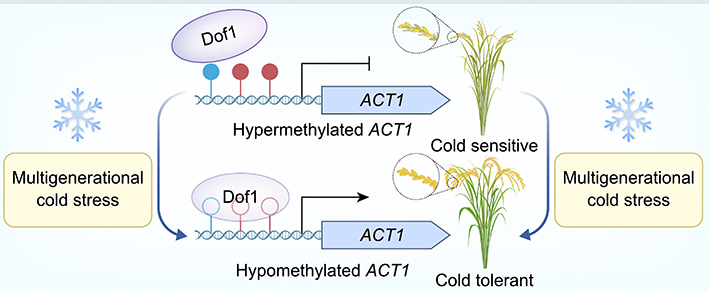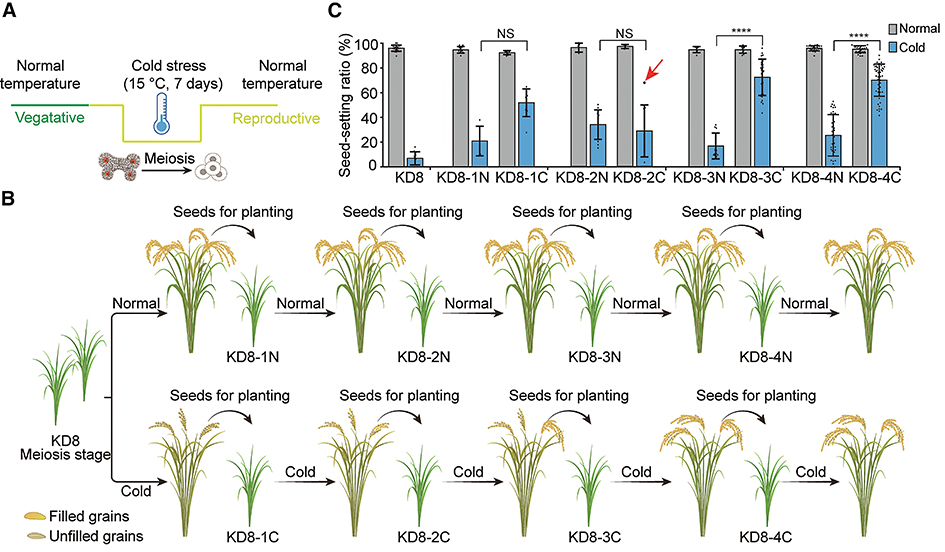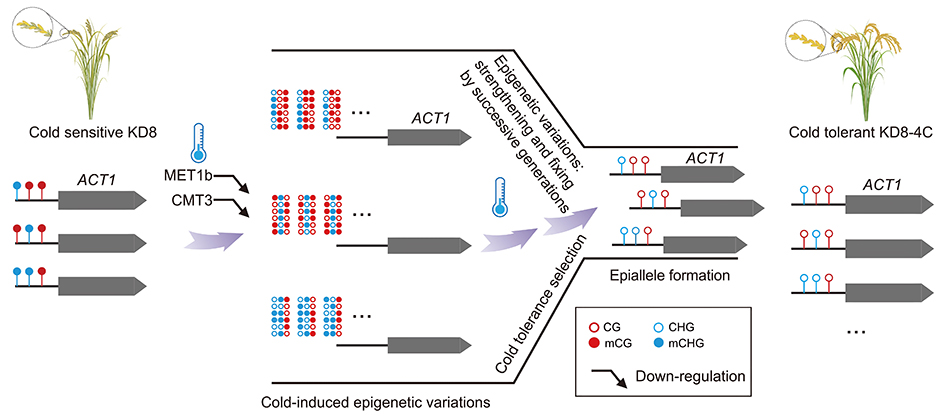By YAN Fusheng
A recent discovery in rice has revealed an elegant trick of nature: crops can teach their later generations to survive the cold through inherited memories written in chemical marks on the DNA letters, representing the first clear demonstration of what scientists call the “inheritance of acquired characteristics”—a phenomenon that biologists have debated for over two centuries.

Cold stress experienced over multiple generations removes chemical “off switches” from a key rice gene named ACT1, allowing the plants to develop inherited cold tolerance that helps them survive in northern climates. (Graphic: IGDB)
In the grand theater of evolution, we’ve long believed that survival traits must be earned through the slow grind of genetic mutations—random changes in DNA that, over countless generations, might grant an organism better odds of survival. But rice—those humble grains feeding half the world—has just challenged this conventional wisdom with a revelation that would make even Darwin pause in wonder.
Scientists have discovered that rice plants can acquire cold tolerance under three generations of cold stress and pass this crucial survival skill to their offspring—not through genetic changes, but through molecular “memory marks” on DNA letters that remember harsh winters and prepare future generations for the chill. This finding, published in Cell by researchers from the Institute of Genetics and Developmental Biology (IGDB) of the Chinese Academy of Sciences (CAS), represents the first clear demonstration of what scientists call the “inheritance of acquired characteristics”—a phenomenon that biologists have debated for over two centuries.
How Rice Colonizes the Cold Regions
The story begins with a simple question that has profound implications: How did tropical rice, originally a heat-loving plant, manage to colonize the cold regions of northern China? Traditional evolutionary theory suggests this adaptation required genetic mutations accumulated over thousands of years. But the new research reveals a far more elegant solution—one that operates like a biological thermostat with memory.
A research team led by Prof. CAO Xiaofeng, a CAS member, and Dr. SONG Xianwei from IGDB embarked on what seemed like a straightforward experiment. They took KenDao8, a rice variety notoriously sensitive to cold, and subjected it to repeated cold stress during its most vulnerable period—when pollen develops during reproduction. This timing proved crucial because rice, like many plants, becomes extraordinarily sensitive to temperature during meiosis, the cellular process that creates reproductive cells.

Rice acquires adaptive cold tolerance after three generations by repeated exposure to cold stress (15 ℃, 7 days) during meiosis stage—the reproductive phase when rice plants form pollen and egg cells for seed production. (Graphic: IGDB)
By the third generation, something remarkable happened: the rice had not only acquired significant cold tolerance but could pass this trait to offspring that had never experienced cold stress themselves. Even more astonishing, this acquired tolerance persisted for at least five generations without any cold exposure—a stability that rivals genetic inheritance.
When the researchers compared the genomes of cold-tolerant and cold-sensitive rice plants, they discovered something intriguing: the DNA sequences were virtually identical, with only minor differences that couldn’t account for the dramatic change in cold tolerance.
The Real Hero
The real hero lurked in the realm of epigenetics—the molecular switches that control gene activity without changing the underlying DNA code. Think of DNA as a massive library and epigenetic marks as the librarians who decide which books get read and which remain on the shelf. In this case, cold stress had removed molecular “bookmarks” called methyl groups from a specific gene called ACT1 (acquired cold tolerance 1).
This demethylation—the removal of chemical tags that normally silence genes—kicks ACT1 into action. As a result, plants could maintain crucial cellular functions even when temperatures dropped.
The elegance of this system becomes apparent when the researchers examined the molecular machinery involved. ACT1 encodes a protein called arabinogalactan protein 1 (AGP1), which may function as a cellular calcium sponge, helping plants sense and respond to environmental stress. When temperatures drop, a transcription factor called Dof1 normally tries to activate ACT1, but in cold-sensitive plants, methylation blocks this activation. In cold-adapted plants, however, the removal of methylation allows Dof1 to successfully turn on ACT1, maintaining the plant’s ability to cope with cold stress.
To prove their hypothesis, the researchers employed cutting-edge DNA editing tools to artificially remove or add methylation at the ACT1 gene. When they demethylated ACT1 in cold-sensitive plants, these plants gained cold tolerance. Conversely, when they restored methylation in cold-tolerant plants, the plants lost their cold tolerance—a molecular switch that could be flipped back and forth like a light dimmer.
The implications extend far beyond laboratory experiments. When the scientists surveyed rice varieties across China’s diverse climate zones, they discovered a striking pattern: varieties from northern, colder regions predominantly carried the unmethylated, cold-tolerant version of ACT1, while southern varieties typically had the methylated, cold-sensitive form. This geographical distribution suggests that during rice’s northward expansion over centuries, natural selection favored plants carrying the cold-tolerant epigenetic variants or epialleles—genes with altered activity due to methylation changes rather than DNA sequence mutations.
Perhaps most intriguing is, the researchers identified, the molecular mechanism behind this epigenetic variation and inheritance. “Cold stress reduces the activity of MET1b, an enzyme that maintains DNA methylation patterns. This disrupts methylation maintenance at ACT1, and repeated cold exposure across generations likely strengthens this effect, creating stable low-methylation variants (mainly at CG sites),” explains Dr. SONG, one of the lead authors. “Unlike in animals, where DNA methylation gets ‘reset’ twice during reproduction, plants maintain their methylation patterns across generations. This stability allows plants to develop heritable epialleles.”

The molecular mechanism behind the inheritance of acquired adaptive cold tolerance in rice. (Graphic: IGDB)
Epigenetic Mechanism in Evolution
This discovery challenges fundamental assumptions about how evolution operates. Rather than waiting for random genetic mutations to provide adaptive advantages, organisms might actively respond to environmental challenges by adjusting their epigenetic landscapes—changes that can be inherited and provide immediate survival benefits.
The research also raises fascinating questions about agricultural adaptation in an era of climate change. If crops can acquire stress tolerance through epigenetic mechanisms within just a few generations, breeders might be able to “train” crops to tolerate environmental stresses through controlled exposure regimens.
However, the scientists acknowledge important limitations to their findings. The cold acclimation process requires precise timing—plants must experience stress during specific developmental stages—and not all varieties may respond equally. Additionally, while the current study focused on cold tolerance, whether similar mechanisms operate for other environmental stresses like drought or heat remains an open question.
The broader implications of this research extend into evolutionary biology itself. For over 200 years, scientists have debated whether organisms can inherit acquired characteristics—traits gained during an individual’s lifetime rather than through genetic inheritance. This study provides compelling evidence that such inheritance not only occurs but plays a crucial role in adaptation to environmental challenges.
As our planet faces unprecedented climate volatility, understanding how organisms naturally acquire and transmit stress tolerance becomes increasingly urgent. Rice’s molecular memory system offers both insights into fundamental biological processes and potential pathways for developing climate-resilient crops. In essence, these humble grains have taught us that sometimes evolution’s most powerful tool isn’t changing the genetic code—it’s learning to read it differently.
Reference
Song, X., Tang, S., Liu, H., et al. (2025) Inheritance of acquired adaptive cold tolerance in rice through DNA methylation. Cell. doi:10.1016/j.cell.2025.04.036

